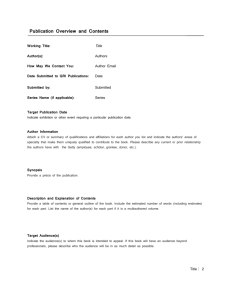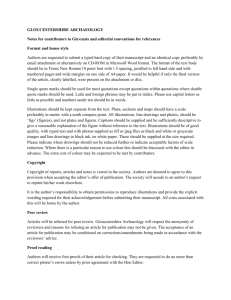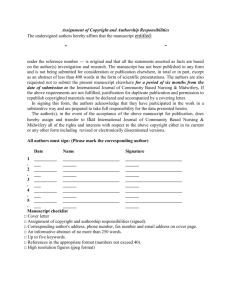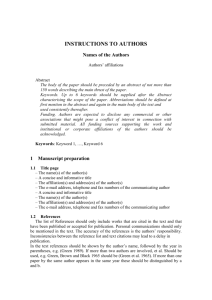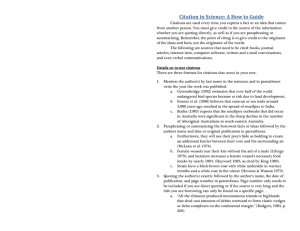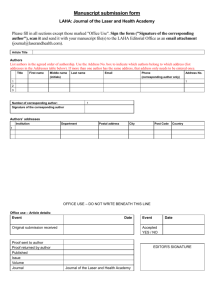Inst. to Authors(IJMS)
advertisement
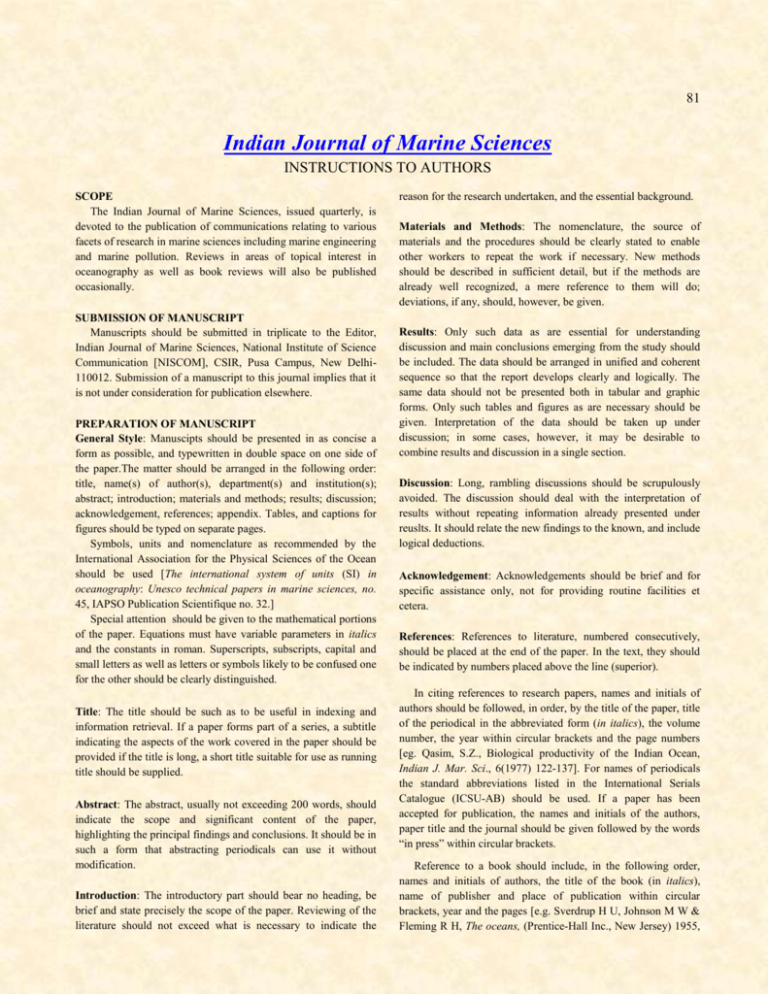
81 Indian Journal of Marine Sciences INSTRUCTIONS TO AUTHORS SCOPE The Indian Journal of Marine Sciences, issued quarterly, is devoted to the publication of communications relating to various facets of research in marine sciences including marine engineering and marine pollution. Reviews in areas of topical interest in oceanography as well as book reviews will also be published occasionally. SUBMISSION OF MANUSCRIPT Manuscripts should be submitted in triplicate to the Editor, Indian Journal of Marine Sciences, National Institute of Science Communication [NISCOM], CSIR, Pusa Campus, New Delhi110012. Submission of a manuscript to this journal implies that it is not under consideration for publication elsewhere. PREPARATION OF MANUSCRIPT General Style: Manuscipts should be presented in as concise a form as possible, and typewritten in double space on one side of the paper.The matter should be arranged in the following order: title, name(s) of author(s), department(s) and institution(s); abstract; introduction; materials and methods; results; discussion; acknowledgement, references; appendix. Tables, and captions for figures should be typed on separate pages. Symbols, units and nomenclature as recommended by the International Association for the Physical Sciences of the Ocean should be used [The international system of units (SI) in oceanography: Unesco technical papers in marine sciences, no. 45, IAPSO Publication Scientifique no. 32.] Special attention should be given to the mathematical portions of the paper. Equations must have variable parameters in italics and the constants in roman. Superscripts, subscripts, capital and small letters as well as letters or symbols likely to be confused one for the other should be clearly distinguished. Title: The title should be such as to be useful in indexing and information retrieval. If a paper forms part of a series, a subtitle indicating the aspects of the work covered in the paper should be provided if the title is long, a short title suitable for use as running title should be supplied. Abstract: The abstract, usually not exceeding 200 words, should indicate the scope and significant content of the paper, highlighting the principal findings and conclusions. It should be in such a form that abstracting periodicals can use it without modification. Introduction: The introductory part should bear no heading, be brief and state precisely the scope of the paper. Reviewing of the literature should not exceed what is necessary to indicate the reason for the research undertaken, and the essential background. Materials and Methods: The nomenclature, the source of materials and the procedures should be clearly stated to enable other workers to repeat the work if necessary. New methods should be described in sufficient detail, but if the methods are already well recognized, a mere reference to them will do; deviations, if any, should, however, be given. Results: Only such data as are essential for understanding discussion and main conclusions emerging from the study should be included. The data should be arranged in unified and coherent sequence so that the report develops clearly and logically. The same data should not be presented both in tabular and graphic forms. Only such tables and figures as are necessary should be given. Interpretation of the data should be taken up under discussion; in some cases, however, it may be desirable to combine results and discussion in a single section. Discussion: Long, rambling discussions should be scrupulously avoided. The discussion should deal with the interpretation of results without repeating information already presented under reuslts. It should relate the new findings to the known, and include logical deductions. Acknowledgement: Acknowledgements should be brief and for specific assistance only, not for providing routine facilities et cetera. References: References to literature, numbered consecutively, should be placed at the end of the paper. In the text, they should be indicated by numbers placed above the line (superior). In citing references to research papers, names and initials of authors should be followed, in order, by the title of the paper, title of the periodical in the abbreviated form (in italics), the volume number, the year within circular brackets and the page numbers [eg. Qasim, S.Z., Biological productivity of the Indian Ocean, Indian J. Mar. Sci., 6(1977) 122-137]. For names of periodicals the standard abbreviations listed in the International Serials Catalogue (ICSU-AB) should be used. If a paper has been accepted for publication, the names and initials of the authors, paper title and the journal should be given followed by the words “in press” within circular brackets. Reference to a book should include, in the following order, names and initials of authors, the title of the book (in italics), name of publisher and place of publication within circular brackets, year and the pages [e.g. Sverdrup H U, Johnson M W & Fleming R H, The oceans, (Prentice-Hall Inc., New Jersey) 1955, 82 Indian J. Mar. Sci., Vol. 31, No. 1, March 2002 pp. 1087]. If the reference is to the work of an author published in a book by a different author or edited by a different person, the fact that it is cited from the source book (in italics) should be clearly indicated. [Azam F & Smith D C, Bacterial influence on the variability in the ocean's’biogeochemical state : A mechanistic view, in: Particle analysis in oceanography, edited by S. Demers, (Springer-Verlag, Berlin) 1991, pp. 213-216]. Proceedings of conferences and symposia should be treated in the same manner as books. Reference to a paper presented at a conference, the proceedings of which are not published, should include, in the following order, names and initials of authors, title of the paper (in italics), name of the conference, place where the conference was held and date (e.g. Sastry L S, The salinity minimum in the Arabian Sea, paper presented at the Symposium on Indian Ocean and Adjacent Seas-Their Origin, Science and Resources, Cochin, 1971). Reference to a thesis should include the name of the author, title of the thesis (in italics), university or institution to which it was submitted and year of submission [e.g. Naqvi, S.W., Relationships between nutrients and dissolved oxygen and nitrate reduction in the Arabian Sea, Ph.D. thesis, University of Poona, India, 1986]. Reference to a patent should include names of patentees, country of origin (in italics) and patent number, the organization to which the patent has been assigned within circular brackets, date of acceptance of the patent and reference to an abstracting periodical where available [e.g. Trepagnier J H, US Pat. 2,463,219 (to E.I. du Pont de Nemours & Co.). 1 March 1949, Chem Abstr. 43 (1949) 7258]. Even if a reference contains more than two authors, the names of all the authors should be given. The abbreviations et al., idem and ibid should be avoided. Unpublished papers and personal communications should also be included in the references [e.g. Pande A.B, unpublished work/data); (Pande A B; personal communication). Tables: Tables should be typed on separate sheets of paper without any text matter on the page. They should be numbered consecutively in Arabic numerals and should bear brief titles. Column headings should be brief. Units of measurement should be abbreviated and placed below the headings. Negative result should be indicated as ‘Nil’ and absence of a datum by a dash. Inclusion of structural formulae inside the tables should be avoided. Illustrations: Two sets of illustrations are to be submitted. Illustrations must be numbered consecutively in Arabic numerals. Captions and legends to the fitures should be self-explanatory and should be typed on a separate sheet of paper and attached at the end of the manuscript. Line drawings should be made in Indian ink on white drawing paper (preferably Bristol board), cellophane sheet or tracing cloth. For satisfactory reproduction, the graphs and line drawings should be drawn to approximately twice the printed size. The size of letters, numbers, dots, lines, etc. should be sufficiently large to permit reduction to the page or the column size, as required in the journal, without loss of detail. In the case of photographs prints must be on glossy paper and must show good contrast. If an illustration is taken from another publication, reference to the source should be given and prior permission be secured. Illustrations should be protected by thick cardboard packing against damage during transit. Illustrations should be referred to in the text by numbers. It will be authors responsibility to get the maps of India or parts thereof approved by the appropriate authority. Whenever a Table or an Illustration is reproduced as such from a published source, author(s) must obtain prior permission from the Publisher/Author to avoid ‘copyright’ problems. Obtaining the permission is entirely the responsibility of the author and not that of the editorial office of IJMS. Footnotes: Footnotes should be avoided as far as possible. Essential footnotes may, however, be indicated by superscribed reference marks (*, †, ‡, ). Identification: It is particularly important that the authors get their biological material authentically identified and quote at least once, on its first citation in the paper, the technical name of the species concerned in full proceded by its popular name where possible, e.g. The shrimp Metapenaeus monoceros (Fabr). Reprints: Twenty-five reprints (25) will be supplied gratis. No additional reprints will be supplied even on payment.

